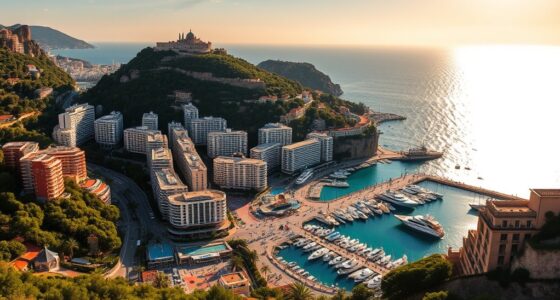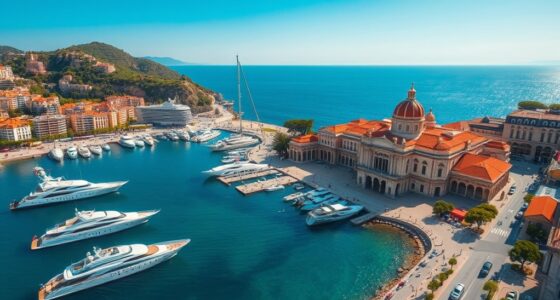Monégasque cuisine blends Provençal and Italian influences, highlighting fresh seafood, herbs, and regional ingredients. You’ll find traditional dishes like Socca, Pissaladière, and seafood stews that celebrate the Mediterranean coastline. Markets, street vendors, and elegant restaurants serve authentic flavors that reflect Monaco’s maritime history and cultural pride. From family recipes to modern culinary innovations, Monaco’s food scene offers a rich tapestry of traditions and tastes waiting to be explored further.
Key Takeaways
- Monaco’s cuisine blends Provençal and Niçoise flavors, emphasizing seafood, fresh vegetables, herbs, and olive oil.
- Traditional dishes like Socca, Pissaladière, and Barbagiuan symbolize regional heritage and community identity.
- Seafood plays a central role, with dishes highlighting freshness and simplicity, reflecting Monaco’s maritime culture.
- Food markets, street stalls, and historic restaurants showcase local ingredients and culinary traditions.
- Modern influences and tourism have introduced innovative techniques and fusion dishes, enriching Monaco’s culinary scene.
Influences Shaping Monégasque Cuisine

Monégasque cuisine has been shaped by a rich tapestry of cultural influences, primarily from southern France and Italy. You’ll notice the Provençal and Niçoise flavors in many dishes, reflecting Monaco’s geographic closeness and historical ties to southern France. Italian influences are also prominent, especially in baked goods and pasta-inspired dishes, highlighting Monaco’s proximity and cultural exchanges with Italy. These influences come together through shared ingredients like olive oil, fresh vegetables, and seafood, which are staples in local cooking. The Mediterranean climate fosters a diet rich in fish, herbs, and produce, blending French sophistication with Italian warmth. This fusion creates a unique culinary identity that celebrates regional flavors while embracing a diverse, multicultural heritage. Additionally, the use of recycled products in some local food presentation and packaging demonstrates Monaco’s commitment to sustainability and environmental consciousness.
Traditional Dishes and Their Significance
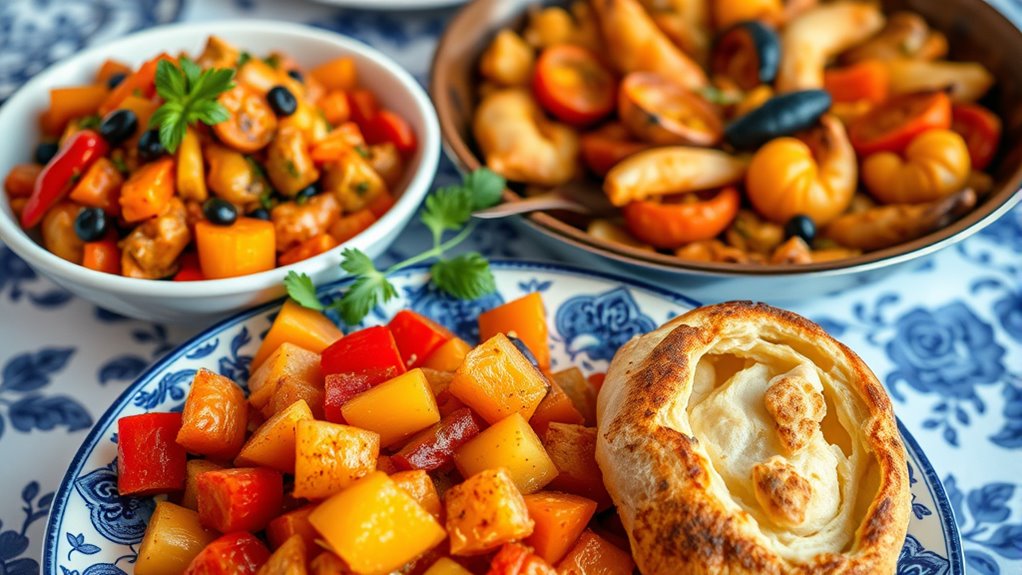
Have you ever wondered how traditional dishes reflect Monaco’s cultural heritage? Dishes like the savory Barbagiuan, filled with Swiss chard and cheese, showcase resourcefulness and family traditions. Pissaladière, with its caramelized onions and olives, highlights Provençal influences and local flavors. Fougasse, a sweet bread flavored with oranges and decorated with nuts, embodies the region’s love for aromatic ingredients. Stocafi, dried cod stewed with vegetables and olives, celebrates the Mediterranean’s connection to the sea and local fishing practices. These dishes aren’t just food; they symbolize Monaco’s history, community, and resilience. Serving these recipes during celebrations strengthens cultural bonds, passing heritage from generation to generation. Each dish preserves a piece of Monaco’s identity, making its culinary traditions an essential part of the nation’s soul.
The Role of Seafood in Local Cooking

Seafood plays a central role in Monaco’s culinary traditions, reflecting its Mediterranean coastline and fishing heritage. You’ll find fresh fish and shellfish featured in many dishes, showcasing the region’s bounty. This focus on seafood highlights Monaco’s connection to the sea, emphasizing quality and simplicity. You might enjoy:
- Grilled fish seasoned with herbs and olive oil, served with local vegetables.
- Seafood stews, like bouillabaisse, packed with fish, shellfish, and aromatic herbs.
- Marinated sardines or anchovies, often enjoyed as appetizers or street food.
These dishes emphasize freshness and highlight the importance of seafood in local celebrations. Whether in casual markets or fine dining, seafood remains a crucial part of Monaco’s culinary identity, connecting tradition with contemporary flavors. Additionally, the use of color accuracy in seafood presentation enhances visual appeal, making dishes more enticing.
Regional Flavors and Ingredients
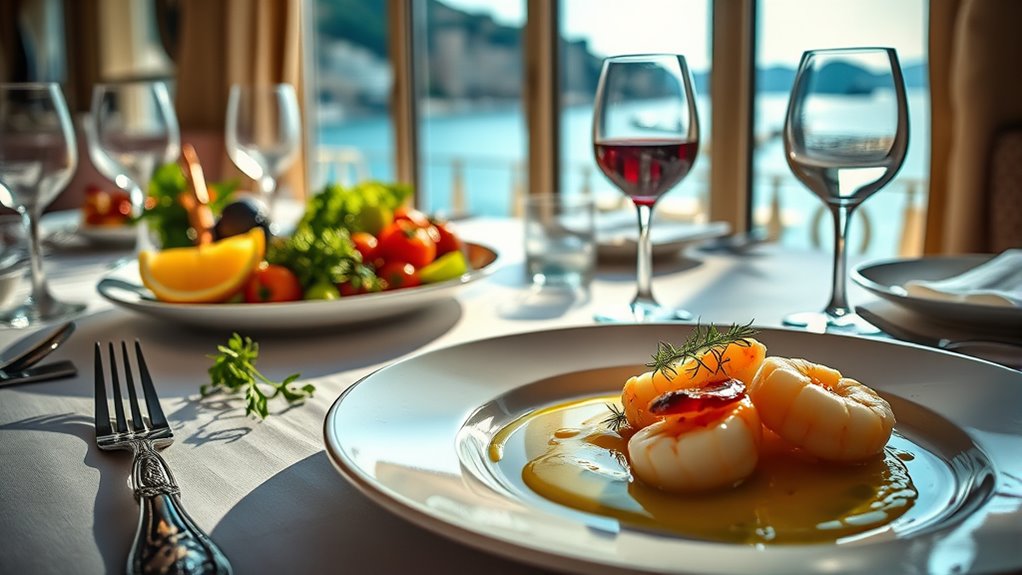
Regional flavors in Monaco are defined by a harmonious blend of local ingredients and influences from neighboring Provençal and Italian cuisines. You’ll notice the prominence of fresh seafood, such as fish, octopus, and shellfish, which reflect the Mediterranean’s bounty. Olive oil plays a central role, used generously in salads, dips, and cooking. You’ll also find vibrant vegetables like Swiss chard, zucchini, and tomatoes that add color and flavor to many dishes. Herbs such as thyme, oregano, and basil are essential, enhancing everything from stews to baked goods. Citrus fruits, especially oranges, bring a bright note to desserts and baked treats. This mix of simple, fresh ingredients and aromatic herbs creates Monaco’s distinctive regional taste, rooted in the Mediterranean’s culinary traditions. Incorporating aromatic herbs, such as thyme and basil, not only elevates the flavor but also supports emotional expression and creativity in cooking.
Cultural Heritage and Culinary Identity

Your culinary heritage in Monaco is reflected through traditional dishes like Barbagiuan, which embody local history and family traditions. The ingredients used often symbolize resourcefulness and connection to the land, such as olives and herbs. Celebrations and festivals further reinforce how food serves as a symbol of cultural identity and community pride. Emphasizing cultural heritage in culinary practices highlights the importance of preserving traditional recipes and techniques for future generations.
Heritage in Traditional Dishes
Traditional dishes in Monaco embody the deep cultural heritage and culinary identity of the region, reflecting centuries of local craftsmanship and communal values. These recipes connect you to the history, showcasing resourcefulness and regional pride. You can see this in:
- Barbagiuan – A symbol of family tradition, it represents Monaco’s creativity in turning simple ingredients into a celebratory dish.
- Fougasse – Its sweet, citrus-flavored bread reflects local agricultural influences and festive customs.
- Stocafi – A hearty seafood stew that celebrates Monaco’s maritime heritage and reliance on Mediterranean ingredients.
These dishes preserve the cultural narrative, serving as edible links to Monaco’s past and community spirit. They remind you of shared memories and the importance of culinary continuity. Incorporating traditional ingredients also highlights the region’s resourcefulness and commitment to preserving authentic flavors.
Symbolism of Local Ingredients
The ingredients central to Monaco’s cuisine—olive oil, fresh vegetables, and seafood—serve as powerful symbols of the region’s cultural heritage and culinary identity. Olive oil reflects the Mediterranean’s long-standing agricultural traditions, embodying simplicity and purity. Fresh vegetables like Swiss chard and zucchini symbolize the region’s reliance on local, seasonal produce, highlighting resourcefulness. Seafood, abundant from the Mediterranean Sea, signifies Monaco’s maritime history and connection to the sea’s bounty. These ingredients are more than just staples; they represent resilience, tradition, and the community’s relationship with nature. Using them in dishes like Socca and Stocafi reinforces Monaco’s culinary identity, blending local heritage with Mediterranean influences. Together, these ingredients tell the story of Monaco’s rich cultural tapestry and enduring culinary spirit.
Cultural Celebrations and Food
Food plays a central role in Monaco’s cultural celebrations, serving as a vibrant expression of its heritage and identity. During festivals and gatherings, traditional dishes connect communities and honor history. You’ll find that:
- Family recipes, like Barbagiuan, are shared during special occasions, symbolizing resourcefulness and creativity.
- Local ingredients such as seafood and vegetables are used to prepare dishes that reflect Monaco’s Mediterranean roots.
- Food festivals highlight the importance of cuisine in preserving cultural heritage, attracting tourists enthusiastic to experience authentic flavors.
- Recognizing the significance of traditional practices, many festivals incorporate cultural celebrations that showcase regional culinary arts and storytelling.
These celebrations reinforce Monaco’s culinary identity, blending tradition with modern influences. They offer a chance for locals and visitors alike to appreciate the rich flavors that define Monaco’s cultural fabric.
Modern Developments in Monaco’s Food Scene
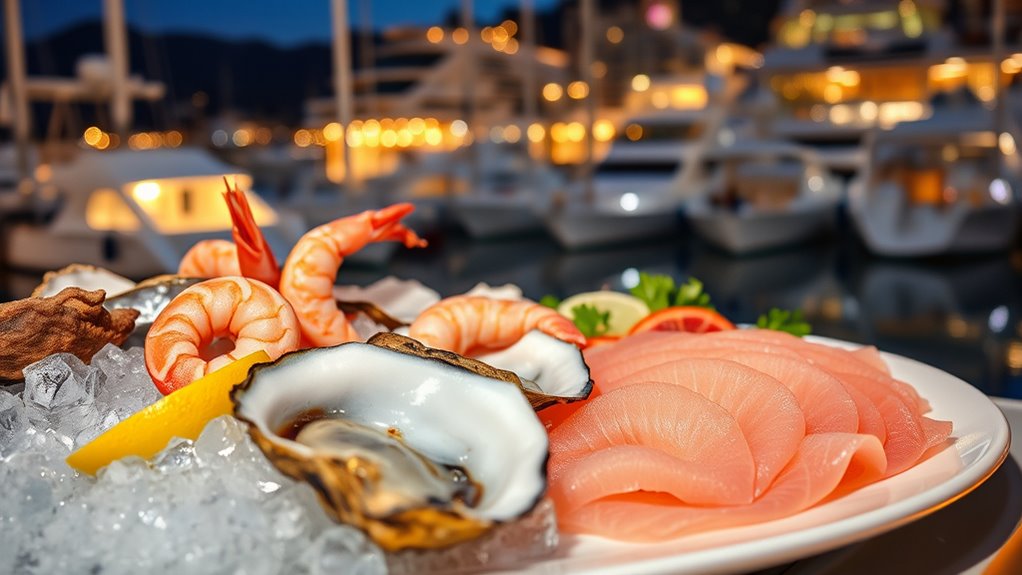
Modern developments in Monaco’s food scene reflect a dynamic blend of tradition and innovation, driven by the city-state’s cosmopolitan atmosphere. You’ll notice how chefs incorporate international flavors into traditional dishes, creating fresh, exciting menus. Michelin-starred restaurants push culinary boundaries with inventive techniques and presentation, elevating Monaco’s reputation as a gourmet hub. Local eateries now experiment with modern recipes that honor heritage while appealing to contemporary tastes. Food festivals celebrating Monaco’s culinary diversity attract both locals and visitors, showcasing everything from classic Pissaladière to innovative seafood creations. Accessibility has also improved, with traditional dishes like Socca and Fougasse featured prominently in markets and casual dining spots. Additionally, the integration of culinary innovation techniques in classic recipes ensures that Monaco’s cuisine remains vibrant, relevant, and reflective of its global influences.
Dining Experiences Across Monaco
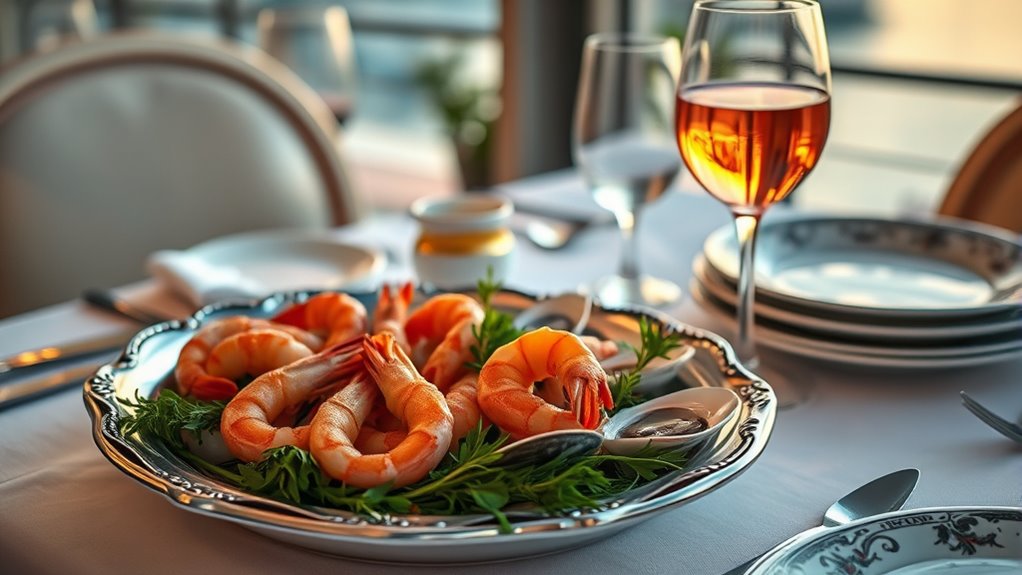
Dining experiences across Monaco showcase a vibrant mix of traditional charm and contemporary sophistication. You can enjoy local flavors in historic settings or indulge in modern culinary artistry. Here are some highlights:
- Old Town Restaurants – Places like Castleroc and La Montgolfière serve authentic Monégasque dishes in charming, centuries-old buildings.
- Street Food – Socca and other quick bites are perfect for casual, on-the-go dining, often enjoyed in lively markets or by the seaside.
- Luxury Venues – High-end hotels and casinos, such as Monte Carlo Casino, offer exquisite fine dining with panoramic views and Michelin-starred menus.
- The use of local ingredients in Monaco’s cuisine enhances the authenticity and freshness of the dishes served throughout the region.
Celebratory and Family Traditions in Food
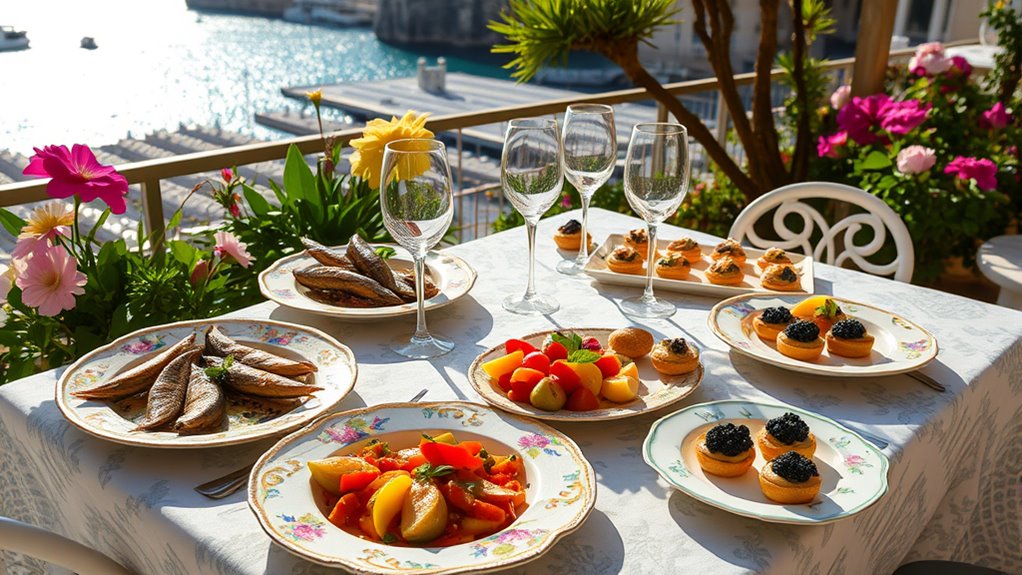
Celebrations and family gatherings are central to Monaco’s culinary traditions, where special dishes like barbagiuan take on deeper meaning. These moments are about more than food; they honor heritage, community, and continuity. Families often prepare traditional recipes together, passing down techniques and stories. During festivals or holidays, dishes are served as symbols of resourcefulness and unity. For example, barbagiuan represents creativity and local pride, often shared during public festivities or private family events. The table below highlights key elements of these traditions:
| Aspect | Significance |
|---|---|
| Traditional Recipes | Preserve cultural identity and family bonds |
| Shared Cooking | Reinforces community and intergenerational ties |
| Special Ingredients | Mark celebration and symbolize abundance |
| Festive Gatherings | Foster social connection and cultural continuity |
| Symbolic Dishes | Reflect resourcefulness and regional pride |
Additionally, incorporating spiritual decor elements into the celebration spaces can enhance the sense of harmony and positivity during these gatherings.
The Impact of Tourism on Local Gastronomy
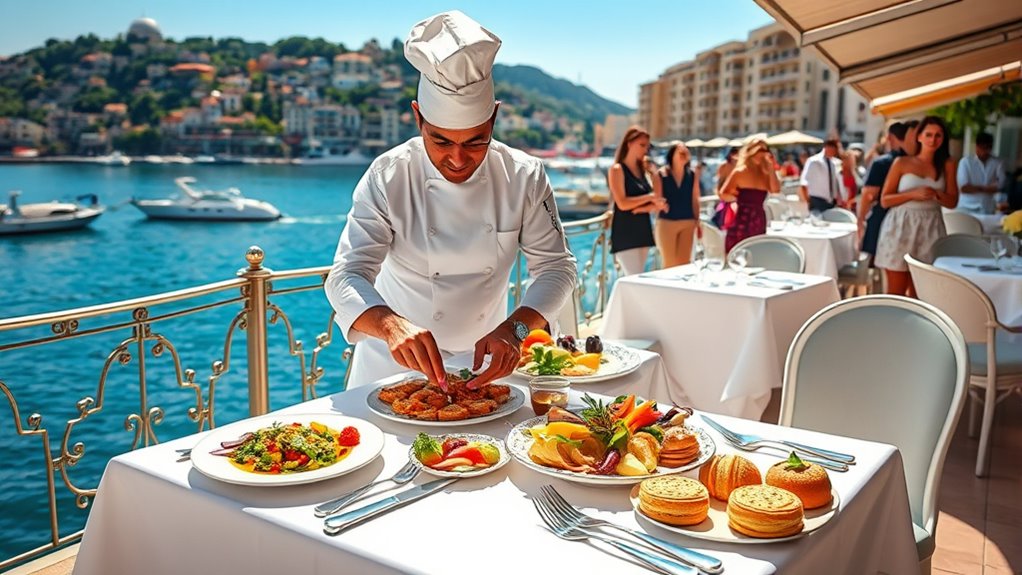
Tourism has brought new culinary influences to Monaco, encouraging fusion dishes that blend local and international flavors. As traditional recipes become more commercialized, they often adapt to meet visitors’ tastes, sometimes altering their authenticity. Meanwhile, the global gastronomic scene continues to shape Monaco’s cuisine, making it more diverse but also challenging its cultural roots. The influx of tourists has also increased the demand for regional culinary resources, which can influence local food practices and preservation efforts.
Culinary Fusion Expansion
As tourists flock to Monaco, they bring diverse culinary expectations that considerably influence local gastronomy. You’ll notice chefs blending traditional Monégasque flavors with international cuisines, creating exciting fusion dishes. This culinary expansion includes:
- Incorporating Asian spices into seafood recipes for a modern twist.
- Combining Mediterranean ingredients with Latin American techniques.
- Introducing global plating styles to elevate presentation and appeal.
These innovations attract a broader audience and encourage chefs to experiment beyond classic recipes. You’ll find restaurants offering dishes like sushi with Provençal herbs or pasta infused with Asian sauces. This fusion reflects Monaco’s vibrant, cosmopolitan vibe, making its cuisine more dynamic without losing its cultural roots. So, your dining experience becomes a blend of tradition and innovation, showcasing how tourism shapes Monaco’s culinary landscape.
Traditional Dishes Commercialization
The popularity of Monaco’s traditional dishes has led to their increased commercialization, especially in areas frequented by visitors. You’ll notice local specialties like Pissaladière and Socca sold in markets, bakeries, and souvenir shops, making them easy to enjoy on the go. Restaurants and cafes often adapt recipes to cater to tourists, sometimes offering simplified or fusion versions. While this boosts local economy and spreads Monaco’s culinary culture, it can dilute authentic flavors and traditional preparation methods. You might find traditional dishes served with less emphasis on regional ingredients or culinary techniques. Despite these changes, many establishments still preserve core elements of Monaco’s gastronomic heritage, providing visitors with a taste of local culture. This commercialization shapes how tourists experience Monaco’s culinary identity.
International Gastronomic Influence
International influences have considerably shaped Monaco’s culinary scene, especially as visitors seek familiar flavors alongside local specialties. You’ll notice that global trends and haute cuisine have enriched Monaco’s gastronomic landscape, blending tradition with innovation. This influx of international cuisine has created a diverse dining environment, appealing to tourists from around the world. Here are three key impacts:
- Fusion Menus: Many restaurants combine local ingredients with international techniques, offering creative dishes.
- Global Restaurants: You’ll find a variety of cuisines, from Japanese sushi bars to Mediterranean tapas.
- Gourmet Events: Food festivals and celebrity chef appearances bring worldwide culinary trends to Monaco’s tables.
This international influence elevates Monaco’s reputation as a global gastronomic hub.
Exploring Monaco’s Food Markets and Street Foods

Have you ever wandered through Monaco’s bustling food markets or sampled street foods on a sunny afternoon? If not, you’re missing out on authentic flavors. In Monaco, markets like Condamine are lively hubs where locals gather for fresh produce, seafood, and regional specialties. Street vendors serve quick bites like socca—chickpea pancakes—and Pissaladière, a flavorful onion tart. These foods reflect Monaco’s Mediterranean roots and vibrant culture. Check out the table below for popular street foods, market ingredients, and where to find them:
| Food Item | Main Ingredients | Common Locations |
|---|---|---|
| Socca | Chickpea flour, olive oil | Street stalls, markets |
| Pissaladière | Onions, olives, tomatoes | Bakeries, markets |
| Fougasse | Oranges, nuts, anise | Local bakeries |
| Seafood Snacks | Fish, lemon, herbs | Market stalls |
Frequently Asked Questions
How Has Monaco’s Cuisine Evolved With International Influences?
You’ll notice Monaco’s cuisine has evolved by incorporating international influences, especially from Michelin-starred restaurants and global culinary trends. You might find traditional dishes with modern twists, blending local flavors with international techniques. This evolution offers a richer dining scene, from high-end experiences at casinos and hotels to casual street foods like socca. As a result, you get to enjoy a diverse, dynamic culinary landscape that respects tradition while embracing global innovation.
What Are the Nutritional Benefits of Traditional Monégasque Ingredients?
You’ll benefit from traditional Monégasque ingredients like olive oil, fresh vegetables, and seafood, which are packed with healthy fats, vitamins, and minerals. Olive oil promotes heart health, while vegetables provide fiber and antioxidants that boost your immune system. Seafood offers omega-3 fatty acids for brain health and reduces inflammation. These ingredients work together to support your overall well-being, making Monaco’s cuisine both delicious and nutritious.
Are There Specific Wine Pairings for Monégasque Dishes?
Imagine you’re at a vintage speakeasy, enjoying Monaco’s traditional dishes. You’ll want to pair seafood like Stocafi with a crisp, chilled Vermentino or a light Rosé, which complements the Mediterranean flavors. For heartier fare like Pissaladière, try a robust Côtes de Provence or a dry local Muscat. These wines enhance the rich herbs and ingredients, making your dining experience as legendary as a 1920s jazz session.
How Do Culinary Traditions Vary Between Monaco’s Coastal and Inland Areas?
You’ll notice that Monaco’s coastal areas focus on seafood, Mediterranean herbs, and light, fresh dishes like Socca and Pissaladière, reflecting the sea’s influence. Inland regions, however, emphasize heartier ingredients like Swiss chard, vegetables, and baked pastries such as Barbagiuan, showcasing local farming traditions. The coastal cuisine leans toward lighter, seafood-based flavors, while inland cooking offers more robust, vegetable-rich dishes, highlighting the diverse culinary heritage across Monaco.
What Are the Most Popular Modern Twists on Traditional Dishes?
Imagine a plate where tradition meets innovation—this is what modern twists on Monaco’s dishes offer. You’ll find Pissaladière topped with caramelized onions and a drizzle of balsamic glaze, or Socca infused with herbs and served with a dollop of flavored aioli. Chefs blend local ingredients with international techniques, creating vibrant, contemporary flavors that honor heritage while exciting your palate with fresh, unexpected sensations.
Conclusion
As you savor Monaco’s vibrant cuisine, remember it’s like a mosaic crafted over centuries—each dish a piece reflecting its diverse influences. When I watched locals share seafood at a seaside café, I saw how tradition and modernity blend seamlessly. Just like that mosaic, Monaco’s culinary scene invites you to explore its rich heritage, reminding you that food isn’t just sustenance but a story that connects us across time and culture.




